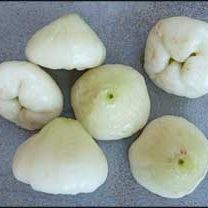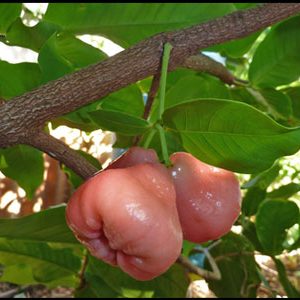Syzygium aqueum
Bell apple, water apple, bell fruit
Origin
Southern Asia and now grown in a number of tropical regions worldwide. Most produce is consumed locally with any export limited to cross-border trade.
Climate
Plants prefer moist tropical lowlands up to 1200m elevation where there is a distinct dry season. This does not mean they’re tolerant of drought conditions, and if drought is prolonged they’ll need irrigation.
Plant Description
An evergreen bush or small tree with a short crooked trunk, 3-8m high, and a non-symmetrical open canopy. The opposite and simple entire leaves are thick, glabrous and glossy, elliptic-obovate, 5-25 X 2-12cm, on short petioles with the presence of oil glands. New foliage occurs rapidly with droopy pink to red leaves turning green as they mature, darker on the upper surface than on the lower
Relatives
A member of the large Myrtaceae family. The genus Syzygium consists of 1200-1500 species with the closest taxonomic relative of the bell apple being S. samarangense, the Java or wax apple. Others in the genus grown for their fruit are rose apple, mountain apple, Java plum, water berry and riberry. The family also includes guava, jaboticaba, grumichama, feijoa, pitanga and many others.
Soils
They grow best in moist heavy soils but can still produce in sandy soils.
Propagation
Some forms have 1 or 2 (rarely up to 6) viable but recalcitrant seeds. Seedlings do not come through true to type and the juvenility period can be 3-7 years. Polyembryony is sometimes observed throughout the genus. Most commonly the seedless forms are grown, so these can be air layered and may begin fruiting in half the time of seedlings. Cuttings can also be successful. Budding on compatible related species (Eugenia javanica, E. densiflora) has also been used with success.
Cultivars
There are no named cultivars commercially available in Australia at present. The main forms seen in Australia are fruit with white or pink skin, sweet and sour fruit, and seeded or seedless.
Flowering and Pollination
The terminal or axillary inflorescences on new wood are umbel-like panicles (corymbs) with 3-7 flowers. Individual flowers are about 3cm in diameter, white-yellow and fragrant. The calyx has 4 fleshy and persistent sepals curved inwards, and the corolla has 4 white-yellow petals. There are numerous white-yellowish stamens about 2cm long, and a persistent and protruding style about the same length and similar colour. Pollination is effected by bees and likely also other insects. They are self-fertile.
Cultivation
Rarely grown in orchards and essentially no development work has been done on the species. Little information is available on best growing practices except that spacing should be 6 X 8 m between trees. The fact that it is a popular tree in the home garden throughout tropical regions suggests cultivation needs are not too demanding. However, some fertilisation after flowering is advisable because new flushes compete with flowers and fruit.
Wind Tolerance
The large leaf size and ease of fruit bruising mean plants should be protected from strong winds. The wood is classified as hard.
Pruning
Little pruning required other than height control and removal of dead wood.
The Fruit
Classified as a berry with a pyriform bell shape, 1.5-2 x 2.5-3cm and the remnants of the white to red fleshy calyx at the concave apex. The thin, glistening, easily bruised skin can vary from white through yellow to pink and red, with white, watery, spongy-crispy, faintly aromatic and thirst-quenching flesh. Depending on variety, it may be seedless or have one to a few round seeds. It is low in calories and has a water content about 90% with no strong nutrition attributes. Taste can sometimes be acid or slightly astringent because of tannins.
Fruit Production and Harvesting
Fast growing tree, with air-layers fruiting within 1-2 seasons. Fruits ripen in stages 35-45 days after anthesis. Harvest is mid-summer in sub-tropical areas, but twice a year in the tropics. After picking they have a short shelf-life at ambient temperature, limiting the possibilities for commercial exploitation. They are chill-sensitive.
Fruit Uses
Mainly eaten fresh as a thirst quencher, but also cut and dipped in sauces or spice mixtures. When sliced it’s a good addition to salads.
Pests and Diseases
Minimal compared to other fruit trees.
Comments
An easy fruit tree to grow in the Perth surrounds, with additional ornamental value. They can crop quite heavily.

